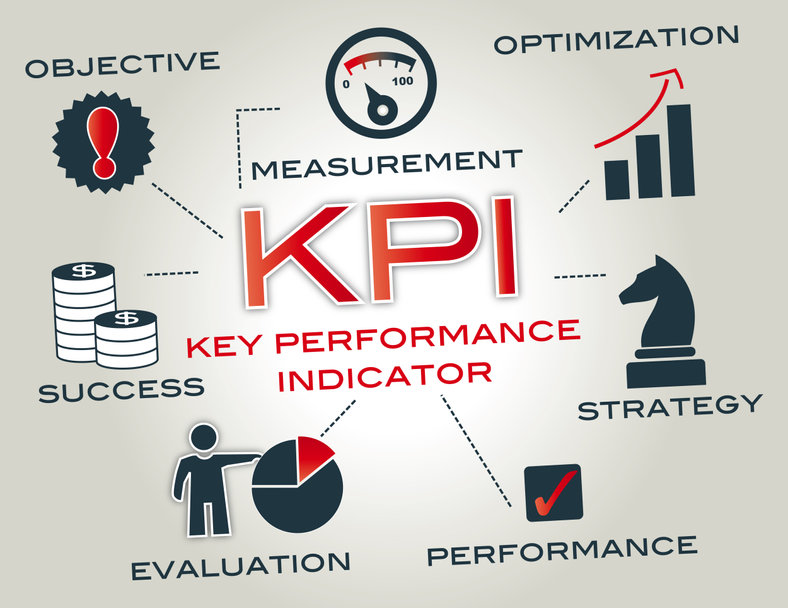
Using key performance indicators (KPIs) in marketing provides information that, when identified and harnessed, helps keep your business on track for continual growth. These measurements, however, are not just about sales revenue or clicks. To use marketing KPIs requires a deeper understanding of behaviors and data which tell the “rest of the story.”
“The simplest way to think about KPIs is to consider the metrics that your organization is willing to spend money on to improve,” writes Laura Patterson in her book Fast-Track Your Business: A Customer-Centric Approach to Accelerate Market Growth. “The KPIs become the basis for how you measure the success of the organization. They are the foundation for the metrics, and measure for each function and person in the organization charged with driving growth.” Even if revenue is on the rise, organizations might assume that all is well and they should continue on the same path. Yet, without a clear set of goals that can be measured and analyzed, companies can miss warning signs, changing trends and overlook crucial opportunities.
Define an Organization’s KPIs
When approaching KPIs, “the focus…is on establishing ideal performance parameters, evaluating actual performance against the parameters and then determining what action is needed as a result,” Patterson advises. Use the following questions to define these parameters:
- What is the ideal outcome?
- Why does this outcome matter?
- How will you measure progress?
- In what ways can you influence the outcome?
- Who is responsible for influencing the outcome, and how?
- How will you understand when the outcome is achieved?
- How often will you review progress toward the outcome?
Four Customer-Centric Marketing KPIs
While there are many KPIs to measure marketing and sales growth, below are the four that we recommend. Why? They position and prioritize the customer as the center of your operations.
- Customer retention. Research shows that typically 65 percent of a company’s business comes from existing customers. Further, studies have shown that an increase in customer retention as small as five percent can boost profits anywhere between 25 and 95 percent. Statistics like this prove that one of marketing’s key goals should be to create meaningful customer relationships over the long term, resulting in recurring revenue from the existing customer base. It’s much less expensive to keep an existing client than it is to attract a new one. To determine your customer retention rate, use this helpful formula on a consistent basis:

- Value per customer. This metric shows how engaged active customers are with your company compared to their potential engagement. What is the average purchase of current clients? Is this number rising? Falling? Which customers are consistently driving sales? Understanding this information helps organizations determine which customers to invest in and how to identify new opportunities with existing clients. It also helps discover new customers and markets. Further, a clear understanding of this metric can help businesses refine and innovate product and service offerings and determine which are not delivering on customers’ needs and expectations.
- Share of wallet. Related to customer value, share of wallet is the dollar amount an average customer regularly devotes to a specific brand rather than to competitors in the same product or service category. Rather than determining the value of each customer, try to determine the total investment they are spending in your market category. By going through this exercise, you can identify where there are opportunities to generate more revenue from current customers and discover new market opportunities.
- Customer satisfaction. How customers are treated before, during and after a purchase has a huge effect on their initial experience and ongoing loyalty. Satisfied customers spread the word within their networks. They also praise their experience with you, your company and your products and services. Those referrals and introductions are invaluable, and they increase your visibility, credibility and name recognition in your marketplaces. To gauge customer satisfaction, use these tools to gather information and understand what it is like being your customer:
- Net Promoter Score (NPS), or how likely a customer is to recommend your product or service
- Customer Satisfaction Score (CSAT), or how satisfied the customer is with the product, service or experience
- Customer Effort Score (CES), or how easy was it to solve the problem associated with their customer interaction.
Construct a Path

Tapping into KPIs effectively requires a forward-thinking perspective, consistent reflection and a commitment to a customer experience that exceeds expectations. By emphasizing this orientation and building your growth strategy accordingly, your organization can use marketing KPIs to shape a path toward continual improvement that will deliver the results you seek.
